EMT與骨肉瘤轉移相關性的研究進展
種 陽,李國軍,張世謙(綜述),邵 明※,楊艷梅(審校)
(1.哈爾濱醫科大學附屬第一醫院骨科,哈爾濱 150001; 2.哈爾濱醫科大學腫瘤防治研究所,哈爾濱150001)
?
EMT與骨肉瘤轉移相關性的研究進展
種 陽1△,李國軍1,張世謙1(綜述),邵 明1※,楊艷梅2(審校)
(1.哈爾濱醫科大學附屬第一醫院骨科,哈爾濱 150001; 2.哈爾濱醫科大學腫瘤防治研究所,哈爾濱150001)
上皮-間質轉化(EMT)是指上皮細胞轉化為間充質細胞的過程,EMT可增強腫瘤細胞的侵襲和轉移能力。既往研究發現,EMT可以通過影響多種基因及通路來影響多種腫瘤的侵襲和轉移,除此之外,EMT也會與細胞周期中的某些酶具有一定的相關性。骨肉瘤細胞作為骨腫瘤中轉移性較強的一種,其轉移性與EMT的關系尚未明確。該文旨在闡明EMT與骨肉瘤細胞轉移性的相互關系,希望可以為抑制骨肉瘤轉移提供新的思路。
骨肉瘤;上皮-間質轉化;轉移
上皮-間質轉化(epithelial-mesenchymal transition,EMT)指具有黏附性的上皮細胞在某些特定的因素下,向著有遷移性的間質細胞轉化的過程,EMT使上皮細胞擁有間質細胞的特性。在惡性腫瘤中,EMT與其侵襲及轉移相關性很大[1-2]。骨肉瘤是一種最常見的惡性程度較高的原發性骨腫瘤,并且屬于間質性癌癥,發病率在骨原發性腫瘤中居第2位;除此之外,骨肉瘤還具有很強的轉移性[3-5]。骨肉瘤的發生、發展與細胞周期、凋亡機制相關,而骨肉瘤的轉移性與骨肉瘤相關基因遠處器官表達、骨肉瘤細胞的侵襲運動及轉移等因素相關。EMT相關的基因和通路很多,現就EMT與骨肉瘤轉移相關性的研究進展予以綜述。
1 EMT簡介
1.1 EMT的概念 EMT是指上皮細胞轉化為間質細胞的過程,這個概念最早由Greenburg和Hay[6]于1982年提出。EMT過程可以使上皮細胞失去極性后獲得間質細胞的移行能力。EMT最初作用于生物胚胎發育過程,后經研究發現,EMT對腫瘤的侵襲及轉移也具有很大的影響[7]。與EMT相關的細胞因子有很多,如N-鈣黏蛋白的上調等;除此之外,EMT會使細胞骨架廣泛重構,游走能力提高,顯著增強同其他間質組織的親和能力,借此來轉移和擴散惡性腫瘤細胞[8-9]。EMT早期轉錄相關因子Zeb1、Snail、Slug、轉化生長因子β (transforming growth factor β,TGF-β)、Twist等使上皮細胞的表達受抑制,同時也增強了轉化后的間質細胞的運動性等特性;基質金屬蛋白酶(matrix metalloproteinases,MMP)2、MMP-9等因子表達上調對這一過程有輔助作用[10-11]。
1.2 EMT與惡性腫瘤的關系 惡性腫瘤的多器官及遠處轉移是患者病死率增高的主要原因。惡性腫瘤的轉移主要為浸潤性種植轉移、血道轉移及淋巴轉移等。近年來研究發現,在肝癌[12]、乳腺癌[13-15]、結腸癌等多種惡性腫瘤中,EMT與其原發性浸潤及繼發性轉移都具有相關性[16]。多條信號通路參與惡性腫瘤的EMT轉化過程,從而使惡性腫瘤細胞具有間質細胞的運動特性而轉移。
1.3 多種信號通路與EMT相關性 多條通路與EMT具有相關性,如Wnt通路、TGF-β通路、Notch通路等。Wnt通路中,Wnt/PCP(平面細胞極性)通路激活Ras家族中的G蛋白,使細胞形態協同極化,同時也使非對稱性細胞骨架形成,從而參與了惡性腫瘤細胞的侵襲和遷移的過程[17]。除此之外,在Wnt/β聯蛋白通路中,通過多種基因的調節,也參與了細胞的EMT的過程;其中,β聯蛋白/上皮鈣黏素復合體起關鍵作用,通過介導細胞之間的黏附,來調控腫瘤細胞的轉移能力;當細胞胞質聚集的β聯蛋白轉入細胞核后,與核內T淋巴細胞因子/淋巴樣增強因子相互作用, 激活下游的眾多靶基因過度表達,從而誘導惡性腫瘤的EMT過程[18]。已有大量的研究表明,TGF-β不僅在胚胎發育過程中有調節EMT的作用[19],在腫瘤EMT過程中也起著重要作用[20]。其機制主要是通過Smad依賴通路[21]和非Smad依賴通路[22]完成的。
2 骨肉瘤簡介
2.1 骨肉瘤的概念 骨肉瘤是一種最常見的惡性程度較高的原發性骨腫瘤,好發于長管狀骨干骺端,如脛骨近端、股骨遠端、肱骨近端及腓骨近端。大部分骨肉瘤為溶骨性,另外一些為成骨性腫瘤。組織學中,骨肉瘤細胞會直接成骨,并且產生骨基質。骨肉瘤會在髓腔內部和骨皮質出現浸潤性擴散。該腫瘤中會出現增生的骨組織、軟骨及纖維組織,發病率在骨原發性腫瘤中居第2位,占原發性惡性骨腫瘤的34%,是青少年和年輕成年人最常見的五大惡性腫瘤之一[23]。除此之外,骨肉瘤還具有很強的轉移性,血行轉移較早出現,多數骨肉瘤患者發現時已發生了肺或者其他器官的轉移,由于轉移性強,造成了骨肉瘤患者病死率比其他惡性腫瘤高的現象[24]。
2.2 骨肉瘤的相關調控 骨肉瘤的發生、發展與細胞周期、凋亡機制等相關,而骨肉瘤的轉移性與骨肉瘤相關基因遠處器官表達、骨肉瘤細胞的侵襲運動及轉移等因素相關。近期的國內外研究表明,多條通路、多數基因或其表達的蛋白與骨肉瘤的發生、發展及轉移具有相關性,如端粒酶、微RNA(microRNA,miRNA)126、b4整聯蛋白、Cyr61、miR-34a、miR-17-92、miR-145、CXCR4、CD133等[25-27]。研究表明,EMT與骨肉瘤的侵襲和轉移具有相關性[28]。
3 EMT與骨肉瘤的相關性
Yu等[29]認為,EMT是轉移的上皮衍生性的一個相關步驟,但在骨肉瘤這樣的間質性組織癌癥中的作用還是不得而知的。在EMT的作用下,癌癥干細胞生長得很快,端粒酶在正常干細胞和一些惡性腫瘤中有維持的作用。近期研究表明,端粒酶活性的異質性存在于獨立的骨肉瘤細胞中[30]。人類端粒酶逆轉錄酶(human telomerase reverse transcriptase,hTERT)啟動子區受體依賴體外MG63的骨肉瘤細胞中的端粒酶活性,并且把hTRET的啟動子區分類為TELpos 和TELneg亞核區兩種;TELpos的細胞出現波形蛋白的高表達,此基因為EMT相關基因,并且通過聚合酶鏈反應、蛋白質印跡法分析發現此基因會顯著促進TELpos細胞的生長;通過體外侵襲實驗證實,TELpos細胞侵襲性很強[31]。實驗結果表明,EMT與間質源性骨肉瘤相關,這也使端粒酶與EMT具有相關性。因此,EMT與骨肉瘤的轉移性具有一定的關系。Shang等[32]認為,T細胞免疫球蛋白的信號可以積極調控肉瘤的發生、發展,研究中通過對9例骨肉瘤患者組織進行免疫組織化學法監測T細胞免疫球蛋白的表達,并且顯性的通過二次免疫熒光來染色;免疫組織化學顯示,只有TIM-3在腫瘤標本中表達,并且定位在腫瘤細胞的細胞質和胞膜;二次免疫熒光染色證實,TIM-3在所有細胞中均有表達(包括CD68+、巨噬細胞、CD31+、內皮細胞、CK-18+上皮細胞及PCNA+腫瘤細胞)。在肉瘤中,TIM-3的表達和EMT的相關因子具有相關性,如波形蛋白、Slug、Snail和Smad。這些結果表明,TIM-3的目標腫瘤細胞會增強EMT的發生,也會增強腫瘤的惡性程度和轉移能力。Ishikawa等[33]認為,EMT會增強癌細胞的惡性程度,其中包括轉移的能力。但是,EMT相關轉錄因子已經成為惡性上皮細胞腫瘤發展的重要因素,他們在間質腫瘤的作用還屬于未知狀態。Twist2基因在人骨肉瘤中為低表達,而在鼠骨肉瘤中表達相反;在體外,鼠類骨肉瘤細胞中過高的Twist2表達會誘導產生抑制細胞生長現象;在體內也會出現顯著地抑制腫瘤形成[34]。在骨肉瘤細胞中,剔除Twist2基因,導入體內會促進腫瘤的形成,表明Twist2在骨肉瘤細胞中是作為抑癌基因存在的,然而,Twist2減少了抑癌基因fibulin-5的表達[35]。在小鼠骨肉瘤細胞中,過度表達Twist2抑制了MMP-9的表達,同時也只抑制對胚胎纖維母細胞的侵襲性;在腫瘤組織中,Twist2的表達也會抑制MMP-9的表達[36]。因此,人骨肉細胞中的Twist2表達較低,從而促進了EMT的過程,因此也會促進骨肉瘤的轉移的發生。Sharili等[37]認為,Snail2是上皮性惡性腫瘤發生的介質,可促進EMT的過程,促進腫瘤的發生和發展。但是,由于骨肉瘤為間質腫瘤,所以對骨肉瘤來說可能并不需要EMT的過程。Snail2在間質性腫瘤中的作用還處于未知狀態,通過剔除和過表達實驗發現,Snail2調節骨肉瘤細胞的侵襲和轉移,剔除Snail2會顯著減低能動性,重構肌動蛋白組成的細胞骨架,并且失去細胞前突,從而負向調節腫瘤的侵襲及轉移[37]。過表達促進其能動性,促進肌動蛋白豐富的細胞前突,在減少黏附性分子OB-鈣黏蛋白的同時,改變了一些非經典Wnt通路中的構成,促進其轉移和侵襲的發生[38]。因此,Snail2可能會成為骨肉瘤臨床上潛在的治療目標基因。就此來說,Snail2基因與EMT過程相關,Wnt通路中也存在與骨肉瘤轉移相關的基因。因此,Snail2與骨肉瘤的轉移具有相關性。Poudel等[39]認為,Ⅰ型膠原在U2OS細胞的形態學、黏附性、增殖和侵襲能力及膠原處理后細胞中細胞外調節蛋白激酶(extracellular regulated protein kinases,ERK)通路的反應中起作用;Ⅰ型膠原會在U2OS細胞中引起EMT過程的出現,與未用膠原處理過培養瓶中的細胞相比,膠原處理過并且與EMT過程相關的培養瓶中細胞出現擴散現象,表明Ⅰ型膠原會促進U2OS細胞的增殖;PD98059處理后,降低了膠原MMP-9的表達,也減少了膠原處理后培養瓶里U2OS的現象。U2OS細胞為骨肉瘤細胞的一種,因此,Ⅰ型膠原與EMT均與骨肉瘤的轉移性相關聯。
4 小 結
隨著醫療水平的提高及分子生物學的研究進展,骨肉瘤的發生、發展及轉移機制越來越明確。臨床上關于骨肉瘤的治療思路及方法也會不斷地進步。通過對EMT與骨肉瘤轉移的相關性的討論,發現骨肉瘤轉移性與多種因素相關,而EMT即是其中的一種機制。EMT可能會成為未來抑制骨肉瘤轉移的一個新的靶點,但仍需進一步研究。而對EMT與骨肉瘤轉移性的具體因素的研究,將是未來研究領域的主要方向和目標。
[1] Thiery JP,Acloque H,Huang RY,etal.Epithelial-mesenchymal transitions in development and disease[J].Cell,2009,139(5):871-890.
[2] Kalluri R,Weinberg RA.The basics of epithelial-mesenchymal transition[J].J Clin Invest,2009,119(6):1420-1428.
[3] Huang G,Nishimoto K,Zhou Z,etal.miR-20a encoded by the miR-17-92 cluster increases the metastatic potential of osteosarcoma cells by regulating Fas expression[J].Cancer Res,2012,72(4):908-916.
[4] Gordon N,Koshkina NV,Jia SF,etal.Corruption of the Fas pathway delays the pulmonary clearance of murine osteosarcoma cells,enhances their metastatic potential,and reduces the effect of aerosol gemcitabine[J].Clin Cancer Res,2007,13 (15 Pt 1):4503-4510.
[5] Koshkina NV,Khanna C,Mendoza A,etal.Fas-negative osteosarcoma tumor cells are selected during metastasis to the lungs:the role of the Fas pathway in the metastatic process of osteosarcoma[J].Mol Cancer Res,2007,5(10):991-999.
[6] Greenburg G,Hay ED.Epithelia suspended in collagen gels can lose polarity and express characteristics of migrating mesenchymal cells[J].J Cell Biol, 1982,95(1):333-339.
[7] Liu Y.New insights into epithelial-mesenchymal transition in kidney fibrosis[J].J Am Soc Nephrol,2010,21(2):212-222.
[8] López-Novoa JM,Nieto MA.Inflammation and EMT:an alliance towards organ fibrosis and cancer progression[J].EMBO Mol Med,2009,1(6/7):303-314.
[9] Savagner P.The epithelial-mesenchymal transition (EMT) phenomenon[J].Ann Oncol,2010,21(Suppl 7):89-92.
[10] Brabletz T.EMT and MET in metastasis:where are the cancer stem cells[J].Cancer Cell,2012,22(6):699-701.
[11] De Craene B,Berx G.Regulatory networks defining EMT during cancer initiation and progression[J].Nat Rev Cancer,2013,13(2):97-110.
[12] Jain S,Singhal S,Lee P,etal.Molecular genetics of hepatocellular neoplasia[J].Am J Transl Res,2010,2(1):105-118
[13] Deka J,Wiedemann N,Anderle P,etal.Bcl9/Bcl9l are critical for Wnt-mediated regulation of stem cell traits in colon epithelium and adenocarcinomas[J].Cancer Res,2010,70(16):6619-6628.
[14] Hlubek F,Spaderna S,Schmalhofer O,etal.Wnt/FZD signaling and colorectal cancer morphogenesis[J].Front Biosci,2007,12:458-470.
[15] Brabletz T,Hlubek F,Spaderna S,etal.Invasion and metastasis in colorectal cancer:epithelial-mesenchymal transition,mesenchymal-epithelial transition,stem cells and beta-catenin[J].Cells Tissues Organs,2005,179(1/2):56-65.
[16] Alkatout I,Wiedermann M,Bauer M,etal.Transcription factors associated with epithelial-mesenchymal transition and cancer stem cells in the tumor centre and margin of invasive breast cancer[J].Exp Mol Pathol,2013,94(1):168-173.
[17] Kurayoshi M,Oue N,Yamamoto H,etal.Expression of Wnt-5a is correlated with aggressiveness of gastric cancer by stimulating cell migration and invasion[J].Cancer Res,2006,66(21):10439-
10448.
[18] Su HY,Lai HC,Lin YW,etal.Epigenetic silencing of SFRP5 is related to malignant phenotype and chemoresistance of ovarian cancer through Wnt signaling pathway[J].Int J Cancer,2010,127(3):555-567.
[19] Mercado-Pimentel ME,Runyan RB.Multiple transforming growth factor-beta isoforms and receptors function during epithelial-mesenchymal cell transformation in the embryonic heart[J].Cells Tissues Organs,2007,185(1/3):146-156.
[20] Lei W,Zhang K,Pan X,etal.Histone deacetylase 1 is required for transforming growth factorbeta1-induced epithelial-mesenchymal transition[J].Int J Biochem Cell Biol,2010,42(9):1489-1497.
[21] Watanabe Y,Itoh S,Goto T,etal.TMEPAI,a transmembrane TGF-beta-inducible rotein,sequesters Smad proteins from active participation in TGF-beta signaling[J].Mol Cell,2010,37(1):123-
134.
[22] Pino MS,Kikuchi H,Zeng M,etal.Epithelial to mesenchymal transition is impaired in colon cancer cells with microsatellite instability[J].Gastroenterology,2010,138(4):1406-1417.
[23] Ferrari S,Palmerini E.Adjuvant combination chemotherapy for osteogenic sarcoma[J].Curr Opin Oncol,2007,19(4):341-346.
[24] Wan X,Kim SY,Guenther LM,etal.Beta4 integrin promotes osteosarcoma metastasis and interacts with ezrin[J].Oncogene,2009,28(38):3401-3411.
[25] Yan K,Gao J,Yang T,etal.MicroRNA-34a inhibits the proliferation and metastasis of osteosarcoma cells both in vitro an in vivo[J].PLoS One,2012,7(3):e33778.
[26] He A,Qi W,Huang Y,etal.CD133 expression predicts lung metastasis and poor prognosis in osteosarcoma patients:A clinical and experimental study[J].Exp Ther Med,2012,4(3):435-441.
[27] Fromigue O,Hamidouche Z,Vaudin P,etal.CYR61 downregulation reduces osteosarcoma cell incasion,migration,and metastasis[J].J Bone Miner Res,2011,26(7):1533-1542.
[28] Eppert K,Wunder JS,Aneliunas V,etal.von Willebrand factor expression in osteosarcoma metastasis[J].Mod Pathol,2005,18(3):388-397.
[29] Yu L,Liu S,Guo W,etal.hTERT promoter activity identifies osteosarcoma cells with increased EMT characteristics[J].Oncol Lett,2014,7(1):239-244.
[30] Tan Y,Tan L,Huang S,etal.Content Determination of Active Component in Huangqi Yinyanghuo Group and Its Effects on hTERT and Bcl-2 Protein in Osteosarcoma[J].J Anal Methods Chem,2014,2014:769350.
[31] Shi YA,Zhao Q,Zhang LH,etal.Knockdown of hTERT by siRNA inhibits cervical cancer cell growth in vitro and in vivo[J].Int J Oncol,2014,45(3):1216-1224.
[32] Shang Y,Li Z,Li H,etal.TIM-3 expression in human osteosarcoma:Correlation with the expression of epithelial-mesenchymal transiton-specific biomarkers[J].Oncol Lett,2013,6(2):490-494.
[33] Ishikawa T,Shimizu T,Ueki A,etal.Twist2 functions as a tumor suppressor in murine osteosarcoma cells[J].Cancer Sci,2013,104(7):880-888.
[34] Tamura M,Noda M.Identification of DERMO-1 as a member of helix-loop-helix type transcription factors expressed in osteoblastic cells[J].J Cell Biochem,1999,72(2):167-176.
[35] Mao Y,Xu J,Li Z,etal.The role of nuclear β-catenin accumulation in the Twist2-induced ovarian cancer EMT[J].PLoS One,2013,8(11):e78200.
[36] Amatangelo MD,Goodyear S,Varma D,etal.c-Myc expression and MEK1-induced Erk2 nuclear localization are required for TGF-beta induced epithelial-mesenchymal transition and invasion in prostate cancer[J].Carcinogenesis,2012,33(10):1965-1975.
[37] Sharili AS,Allen S,Smith K,etal.Snail2 promotes oseosarcoma cell motility through remodelling of the actin cytoskeleton and regulates tumor development[J].Cancer Lett,2013,333(2):170-
179.
[38] Kaufhold S,Bonavida B.Central role of Snail1 in the regulation of EMT and resistance in cancer:a target for therapeutic intervention[J].J Exp Clin Cancer Res,2014,33:62.
[39] Poudel B,Kim DK,Ki HH,etal.Downregulation of ERK signaling impairs U2OS osteosarcoma cell migration in collagen matrix by suppressing MMP9 production[J].Oncol Lett,2014,7(1):215-218.
Relationship between EMT and Metastasis of Osteosarcoma
CHONGYang1,LIGuo-jun1,ZHANGShi-qian1,SHAOMing1,YANGYan-mei2.
(1.DepartmentofOrthopedics,theFirstAffiliatedHospitalofHarbinMedicalUniversity,Harbin150001,China; 2.TumorResearchInstituteofHarbinMedicalUniversity,Harbin150001,China)
Epithelial-mesenchymal transiton (EMT) is a procedure of epithelial cells turning into mesenchymal cells.EMT can enhance the invasive and metastatic abilities of cancer cells.Previous studies showed us that EMT can influence many genes and paths to influence the invasion and metastasis of tumors.Besides,EMT is also associated with some enzymes of cell cycle.Osteosarcoma is one of the bone tumors with strong metastasis.The relationship between EMT and osteosarcoma′s metastasis is little known so far.Here focuses on the correlation between EMT and osteosarcoma′s meatstasis,with the hope to provide new ideas to inhibit the metastasis of osteosacoma.
Osteosarcoma; Epithelial mesenchymal transition; Metastasis
R738.1
A
1006-2084(2015)12-2185-04
10.3969/j.issn.1006-2084.2015.12.027
2014-10-10
2014-12-12 編輯:鄭雪

